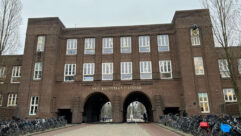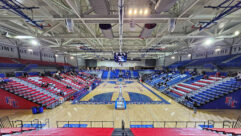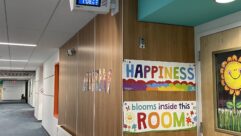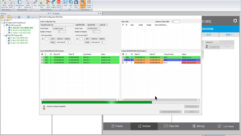Safe Schools: An effective security system was integral to the welfare ofthe Hunstville, AL, school district.
May 1, 1998 12:00 PM,
Steve Hall
Just over a decade ago, Huntsville, AL, city schools were in trouble.Arson, theft and vandalism were out of control. On a single Sundayafternoon, an elementary school lost every computer in its computer lab,150 windows were shattered in another elementary school, 75 were broken ata middle school and a gym floor was flooded at another. Insurance costswere topping $1 million a year, and Huntsville’s insurance agents warnedthat the district might soon become uninsurable.
Faced with that stark assessment, the district took action. A videosurveillance system, along with motion sensors, heat and smoke detectorsand magnetic door switches, was installed. Video information from three to12 cameras at each school was transmitted by microwave radios and relays toa central monitoring station. There, technicians viewed school activity onmore than 40 monitors, 24 hours a day, 365 days a year.
In the first few months the system was operating at the initial set ofschools, burglaries ceased, and vandalism costs were reduced to less than$200. Within a few years, the $1.6 million system had saved more than$500,000 in insurance premiums in addition to the savings from reducedburglaries, vandalism and other criminal activity.
However, after seven years of operation, the system needed to be upgradedand expanded. This proved to be an expensive and difficult process. Eachnew microwave radio set cost $20,000 and required approval from the FederalCommunications Commission, a procedure that could take six to nine months,assuming there were frequencies still available.
District officials began looking at telephone lines as a way to transmitthe video information. However, at the time, an analog signal sent overtraditional phone lines would top out at 14.4 kbps-too slow to beeffective. On the other hand, digital imaging and transmission offered anattractive alternative. During the planning, officials from the localtelephone company, BellSouth, suggested using the Integrated ServicesDigital Network (ISDN) and the Robot HyperScan long-distance picturetransmission system from Sensormatic Electronics.
Unlike traditional telephone service, an ISDN line has not one, but threechannels that can be used to send voice, data and video communicationssimultaneously.
A HyperScan transmitter sends video from security cameras via one ISDNchannel at 38.4 kbps. Alarm control information from motion detectors, heatsensors and other sources are sent over a second channel. The third channelis available for audio, device control and other communications needs.
Don Sadler, Huntsville city schools’ operations director, said the initialmicrowave network connected all 44 school sites to a central monitoringstation at the school board’s administrative offices. That system has nowbeen completely replaced by the ISDN/HyperScan links.
“Our microwave system was state of the art at the time, but moving to ISDNand HyperScan puts us on today’s cutting edge of security systems,” hesaid. “ISDN has proven to be more reliable because it is not affected bysevere weather or line-of-sight limitations, as are microwave systems.
“ISDN lets us expand our network quickly and easily-without FCCapproval-and offers us a separate backup system by simply switching toanother phone line in the event a repair is necessary.”
Also, he estimated the district saved at least $700,000 in hardware costsalone by switching to a phone line-based digital imaging system. Sadlersaid the district also hopes to recoup some of the investment made in itsoriginal security system by selling the microwave radios and some of theother accessories.
The results from the new system have been impressive. Sadler said thecomputer-based system provides the district with higher resolutionpictures, leading to better suspect identification. District securitypersonnel monitor the video images on computer monitors made by NEC. In thenear future, the security staff will be able to fax a digital image of asuspect directly to the local police station or even to a fax-equippedpatrol car.
Moreover, the system has aided school security officers to confiscateweapons, including guns, knives and brass knuckles as well as drugs fromstudents. A number of activities, such as burglaries, fights, trespassing,even a tornado striking a school building, have been captured on video.
Ron Saunders, Ed.D., district superintendent, said he and the members ofthe school board are committed to protecting the school facilities andproviding safe and secure schools for the 25,000 students and 3,000employees.
“For us to be effective, safety has to be our number one priority,” hesaid. “If everyone doesn’t feel safe in school, students cannot learn, andteachers cannot teach. Therefore, this system supports our instructionalefforts by supporting safety in our schools.”
Dr. Saunders said the savings from switching to a HyperScan phone linesystem are being used to augment the district’s instructional budget. Hesaid the new system is also continuing the savings on the district’sinsurance bill.
“We’ve had insurance companies come to us and say we want to insure you,and we’ll give you a rebate because of your security system,” Saunderssaid. “They have told us that they wish all school districts had this typeof security system in place. It reduces vandalism and burglaries, and wefeel very good about that.”
He admitted that some teachers initially had reservations about a “bigbrother” system that made it even easier to keep the schools under constantsurveillance. But, he said, those feelings have changed as teachers andother employees realized they are safer throughout the day, especially whenthey access school grounds after hours.
Dr. Saunders said the phone line security system came into being as theresult of an unusual situation. BellSouth had set up a phone line videosystem linking the superintendent’s home and the district’s board room sothat Saunders could continue to be present-as required by Alabama law-atboard meetings while he recovered from back surgery.
“Our director of operations asked a BellSouth official if we could devise asystem like that one for security purposes,” he said. “And a year later, itwas history.”










